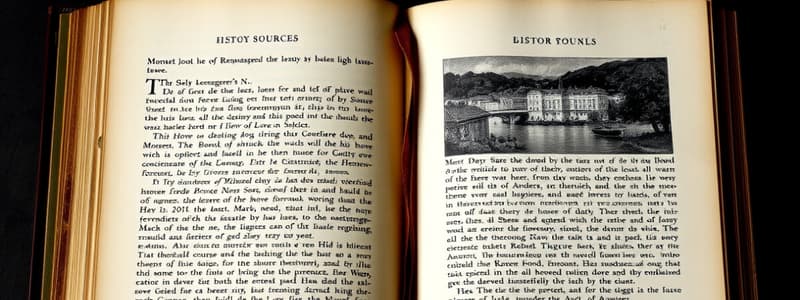Podcast
Questions and Answers
Which type of published material specifically reflects a person's travels?
Which type of published material specifically reflects a person's travels?
- Reading Journals
- Travelogues (correct)
- Magazines
- Memoirs
What is a key characteristic of primary sources?
What is a key characteristic of primary sources?
- They are created by individuals not involved in the events.
- They are materials produced by participants or witnesses of the event. (correct)
- They are second-hand interpretations of events.
- They consist only of published articles.
What type of historical source includes letters, diaries, and photographs?
What type of historical source includes letters, diaries, and photographs?
- Fossils
- Artifacts
- Oral History
- Archival Materials (correct)
Which of the following is NOT considered a non-written source?
Which of the following is NOT considered a non-written source?
Which of the following types of historical sources can provide unique insights into personal experiences?
Which of the following types of historical sources can provide unique insights into personal experiences?
Which type of non-written source focuses on studying events through collected oral accounts?
Which type of non-written source focuses on studying events through collected oral accounts?
What type of published material is specifically designed for recording reading experiences?
What type of published material is specifically designed for recording reading experiences?
Fossils are important historical sources because they provide insights into which aspect of history?
Fossils are important historical sources because they provide insights into which aspect of history?
What defines a written source?
What defines a written source?
Which of the following is NOT considered a primary source?
Which of the following is NOT considered a primary source?
Which repository is located outside NCR?
Which repository is located outside NCR?
Which type of primary source does NOT include visual elements?
Which type of primary source does NOT include visual elements?
What is the primary purpose of secondary sources?
What is the primary purpose of secondary sources?
Which of the following is an example of an artifact?
Which of the following is an example of an artifact?
Which of the following repositories is located in the United States?
Which of the following repositories is located in the United States?
Which category does 'Royal Decrees' belong to?
Which category does 'Royal Decrees' belong to?
Flashcards are hidden until you start studying
Study Notes
Historical Sources
- Historical sources include materials used to write history, classified into three categories: published materials, manuscripts, and non-written sources.
Published Materials
- Books: Provide comprehensive information on historical topics.
- Magazines: Contain articles on current events and historical topics.
- Reading Journals: Designed for recording and reflecting on reading experiences.
- Travelogues: Describe personal travels, offering historical insights into specific places or time periods.
Manuscripts
- Archival Materials: Include letters, diaries, photographs, and other documents maintained in archives.
- Memoirs: Personal accounts of one’s life, valuable for historical insights.
- Diaries: Personal journals capturing thoughts and experiences, providing unique historical perspectives.
Non-Written Sources
- Oral History: The study of the past through collected oral accounts, important for unrecorded events.
- Artifacts: Objects made or used by past societies, revealing cultural and lifestyle details.
- Ruins: Remnants of past structures, informative about architecture and technology.
- Fossils: Preserved remains of ancient organisms, offering insights into the history of life on Earth.
Primary Sources
- Defined as materials produced by individuals directly involved in an event or topic.
- Examples include:
- Eyewitness accounts
- Diaries and letters
- Legal documents
- Photographs
Categories of Primary Sources
- Written Sources: Materials written by eyewitnesses or participants.
- Images: Visual documents created by firsthand participants.
- Artifacts: Materials made by direct participants.
- Oral Testimonies: Documented conversations from firsthand eyewitnesses.
Types of Primary Sources Used
- Fossil Remains
- Artifacts and Ruins
- Royal Decrees and Laws
- Official Reports
- Chronicles
- Friar Accounts
- Maps and Memoirs
- Personal Accounts
- Newspapers and Magazines
- Legislative Journals
- Court Records and Speeches
- Personal Letters
- Online Databases, Blogs, and Documentary Films
- Recorded Interviews
Repositories of Primary Sources
-
In NCR:
- National Archives of the Philippines
- National Library
- National Historical Commission
- National Museum Complex
- Private Museums (e.g., Lopez Memorial Museum, Ayala Museum)
- Key University Libraries (University of the Philippines, Ateneo de Manila, De La Salle University, University of Santo Tomas)
-
Outside NCR:
- Local Archives
- Local Libraries
- NHC Branch Offices
- Local History Museums and Shrines
- Local University Libraries
-
International:
- Library of Congress (USA)
- National Archives and Records Administration (USA)
- Archivo General de Indias (Spain)
- Archive General de la Nación (Mexico)
Secondary Sources
- Defined as materials that analyze and interpret primary sources, providing contextual understanding of historical events.
Studying That Suits You
Use AI to generate personalized quizzes and flashcards to suit your learning preferences.




